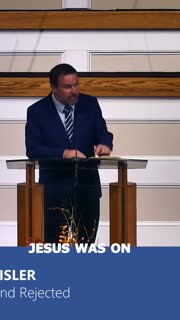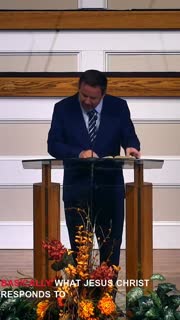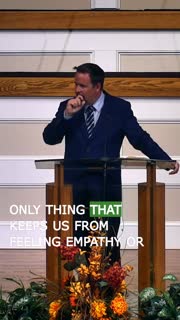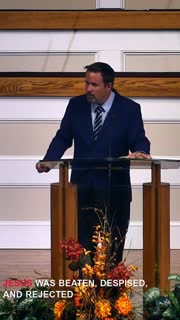Jesus' Journey to the Cross: Love and Sacrifice
Devotional
Sermon Summary
Bible Study Guide
Sermon Clips
1. "Jesus was on His way to the cross. He was on His way to being the sacrificial lamb for the Passover. There was nothing that Pilate was going to be able to do to stop Him. He was going to be able to stop this no matter how hard He may try. At one point, as Pilate was seeking to release Jesus, the religious Jewish leaders cried out in John chapter number 19 and verse number 7, the Jews answered Him, We have a law, and by our law He ought to die, because He made Himself the Son of God." [04:49] (35 seconds)
2. "Basically what Jesus Christ responds to him is, don't you know who I am? Don't you know the power that I have? Don't you know that you have no power at all except it were given to you by me? I am the all-powerful one. I am the creator of all things. Jesus wasn't trapped. Jesus was, his life wasn't hanging in the balance by the word of Pilate. Jesus Christ was on a mission. Jesus was, Jesus was on his way. To being the Passover lamb." [07:38] (34 seconds)
3. "This was not a surprise to God. This didn't catch God off guard. This didn't catch God off guard. This didn't catch God off guard. This didn't catch God off schedule here. This was all part of the plan of God. He knew what man would do. And he knew that man needed someone to pay the price for their sin. He knew he would be despised and rejected of men. He knew that he would be wounded for our transgressions and bruised for our iniquities. He knew that he would be oppressed for the afflicted. Yet he would not open his mouth. He was a lamb brought. To the slaughter, as was prophesied hundreds of years before by the prophet Isaiah. He knew this was coming. He knew he was headed to the cross to be the sacrifice for our sin. He knew that he would be beaten, despised, and rejected. This was not a surprise to him." [09:25] (53 seconds)
4. "Jesus' beating was so severe that he was unable to carry his cross when it was time for his crucifixion. By the time he was on his way to Golgotha, he would have been suffering from blood loss and shock. His breathing was probably labored. His blood pressure would have dropped and his body would most likely at this point be shaking and be trembling. His skin would be dangled like ribbons from his body. John states that Jesus was scourged. This is what he means. That's the suffering he went through." [13:38] (38 seconds)
5. "The only thing that keeps us from feeling empathy or sympathy for others is when we have a hatred in our heart toward that person. That is why a group like Hamas can murder 1,200 people and many Arabs and Muslims. Celebrate on that day. That is why a nation like Israel can destroy much of Palestine and kill people. And the Israelis don't feel bad for them. When there's hatred in someone's heart towards someone else, it blocks the emotions of sympathy and empathy." [19:30] (34 seconds)
6. "Jesus Christ was despised by the religious Jewish leaders so much so that they had no compassion for him even as he stood there beaten and mocked and bloodied. We also see through this passage that Jesus Christ was rejected it says in verse number 12 of chapter 19 and from 4th pilate sought to release him but the jews cried out saying if thou let this man go thou are not caesar's friend whosoever maketh himself a king speaks against caesar." [22:13] (34 seconds)
7. "Jesus was rejected as the messiah he wasn't who they wanted him to be and so they rejected him you know despite all that god has done for us there's still people today who reject him he doesn't fit into the box that they want their god to be he doesn't approve of their sin or of their lifestyle he doesn't do what they they want him to do and so they don't want him they want a god and a king that does things the way that they want it to be done and when jesus is revealed as different than what they want they reject him even to this day." [27:08] (40 seconds)
8. "Jesus was beaten, despised, and rejected for us. Because we deserve to be beaten, despised, and rejected for our sin. But Jesus took that all upon himself. And he took it all the way to the cross to be the Passover lamb, to die. To die in our place. Oh, what love. Oh, what love God has for us. Have you experienced this love? Have you experienced the forgiveness of your sin? That only God can offer you through Jesus Christ. Do you meditate on what your sin calls Jesus Christ? Every time you get angry, every time you envy, every time you covet, every time you lie, that's what Jesus was beaten for. That's what Jesus was crucified for. Sin is not a light matter. But Jesus loved us to die in our place. Oh, what love that he has for us." [29:29] (73 seconds)
Ask a question about this sermon
2. "Basically what Jesus Christ responds to him is, don't you know who I am? Don't you know the power that I have? Don't you know that you have no power at all except it were given to you by me? I am the all-powerful one. I am the creator of all things. Jesus wasn't trapped. Jesus was, his life wasn't hanging in the balance by the word of Pilate. Jesus Christ was on a mission. Jesus was, Jesus was on his way. To being the Passover lamb." [07:38] (34 seconds)
3. "This was not a surprise to God. This didn't catch God off guard. This didn't catch God off guard. This didn't catch God off guard. This didn't catch God off schedule here. This was all part of the plan of God. He knew what man would do. And he knew that man needed someone to pay the price for their sin. He knew he would be despised and rejected of men. He knew that he would be wounded for our transgressions and bruised for our iniquities. He knew that he would be oppressed for the afflicted. Yet he would not open his mouth. He was a lamb brought. To the slaughter, as was prophesied hundreds of years before by the prophet Isaiah. He knew this was coming. He knew he was headed to the cross to be the sacrifice for our sin. He knew that he would be beaten, despised, and rejected. This was not a surprise to him." [09:25] (53 seconds)
4. "Jesus' beating was so severe that he was unable to carry his cross when it was time for his crucifixion. By the time he was on his way to Golgotha, he would have been suffering from blood loss and shock. His breathing was probably labored. His blood pressure would have dropped and his body would most likely at this point be shaking and be trembling. His skin would be dangled like ribbons from his body. John states that Jesus was scourged. This is what he means. That's the suffering he went through." [13:38] (38 seconds)
5. "The only thing that keeps us from feeling empathy or sympathy for others is when we have a hatred in our heart toward that person. That is why a group like Hamas can murder 1,200 people and many Arabs and Muslims. Celebrate on that day. That is why a nation like Israel can destroy much of Palestine and kill people. And the Israelis don't feel bad for them. When there's hatred in someone's heart towards someone else, it blocks the emotions of sympathy and empathy." [19:30] (34 seconds)
6. "Jesus Christ was despised by the religious Jewish leaders so much so that they had no compassion for him even as he stood there beaten and mocked and bloodied. We also see through this passage that Jesus Christ was rejected it says in verse number 12 of chapter 19 and from 4th pilate sought to release him but the jews cried out saying if thou let this man go thou are not caesar's friend whosoever maketh himself a king speaks against caesar." [22:13] (34 seconds)
7. "Jesus was rejected as the messiah he wasn't who they wanted him to be and so they rejected him you know despite all that god has done for us there's still people today who reject him he doesn't fit into the box that they want their god to be he doesn't approve of their sin or of their lifestyle he doesn't do what they they want him to do and so they don't want him they want a god and a king that does things the way that they want it to be done and when jesus is revealed as different than what they want they reject him even to this day." [27:08] (40 seconds)
8. "Jesus was beaten, despised, and rejected for us. Because we deserve to be beaten, despised, and rejected for our sin. But Jesus took that all upon himself. And he took it all the way to the cross to be the Passover lamb, to die. To die in our place. Oh, what love. Oh, what love God has for us. Have you experienced this love? Have you experienced the forgiveness of your sin? That only God can offer you through Jesus Christ. Do you meditate on what your sin calls Jesus Christ? Every time you get angry, every time you envy, every time you covet, every time you lie, that's what Jesus was beaten for. That's what Jesus was crucified for. Sin is not a light matter. But Jesus loved us to die in our place. Oh, what love that he has for us." [29:29] (73 seconds)








